#convex optimisation
Explore tagged Tumblr posts
Text


0 notes
Text
What factors should be considered when installing convex mirrors?
Convex mirrors play a crucial role in enhancing safety and minimising accidents in various settings. Whether it's a busy parking lot, a warehouse with blind spots, or a residential driveway, the strategic installation of convex mirrors can significantly improve visibility and awareness.
In this comprehensive installation guide, let’s delve into the essential factors to consider when installing a convex safety mirrors for optimal effectiveness.
1. Location Selection
The selection of installation locations for convex mirrors is a critical aspect of maximising their effectiveness. When choosing strategic locations, it's essential to consider factors such as blind spots, traffic flow patterns, and potential hazards.
For instance, in a parking lot, the installation of convex mirrors at intersections or areas with limited visibility can help drivers and pedestrians navigate safely. Similarly, in warehouse settings, convex mirrors can be strategically placed to eliminate blind spots and improve overall awareness.
The positioning of convex mirrors should be thoughtfully planned to ensure comprehensive coverage and visibility. By addressing specific areas of concern, such as tight corners or obscured pathways, the installation locations can be optimised for maximum safety enhancement.
2. Mounting Height and Angle
The optimal mounting height and angle of convex mirrors depend on the specific setting in which they are installed. For instance, in parking lots, the mounting height should be adjusted to provide clear visibility for both drivers and pedestrians.
Additionally, the angle of the convex mirror plays a crucial role in capturing a wide field of view without distortion. Tips for ensuring maximum visibility and coverage include adjusting the angle to minimise glare and positioning the mirrors at a height that allows for a clear line of sight.
In warehouse environments, the mounting height and angle should be tailored to address specific blind spots or areas with restricted visibility. By carefully considering the unique characteristics of each setting, the installation of convex mirrors can effectively enhance safety and awareness.

3. Environmental Considerations
When installing convex mirrors, environmental factors such as lighting conditions, weather exposure, and potential obstructions must be taken into account. Outdoor installations, in particular, require durable materials that can withstand varying weather conditions.
The selection of materials resistant to corrosion and damage from environmental elements is crucial for the longevity and effectiveness of convex mirrors in outdoor settings.
Moreover, the positioning of convex mirror in relation to natural and artificial lighting sources can significantly impact their performance. By considering the direction of light and potential glare, the installation can be optimised to provide clear visibility in all lighting conditions.
4. Regulations and Guidelines
Local regulations and industry standards regarding convex mirror installation should be thoroughly researched and adhered to. Compliance with safety guidelines for public spaces and commercial settings is essential to ensure that the installation meets necessary safety standards.
By familiarising oneself with the relevant regulations and guidelines, individuals and businesses can ensure that their installation is not only effective but also legally compliant.
Awareness of industry standards can also inform the selection of appropriate convex mirrors for specific settings, ensuring that the chosen mirrors meet the necessary safety requirements.
5. Maintenance and Inspection
Regular inspection and maintenance are crucial for ensuring the longevity and effectiveness of convex mirrors. Tips for maintenance include periodic cleaning to remove dirt and debris that may obstruct visibility. Additionally, addressing issues such as scratches or damage promptly can prolong the lifespan of convex mirrors and maintain their effectiveness.
By implementing a proactive maintenance routine, individuals and businesses can ensure that their convex mirrors continue to enhance safety and awareness in their respective environments.
Summing Up
The installation of a convex mirror is a proactive measure to enhance safety and minimise accidents in diverse settings. Proper installation and maintenance of convex mirrors play a significant role in creating safer environments for both pedestrians and drivers.
By following the comprehensive guidelines outlined in this installation guide, individuals and businesses can take proactive steps to enhance safety and minimise accidents through the strategic installation of convex mirrors.
Source By - http://tinyurl.com/k52pnpan
0 notes
Text
it’s another “problem with no apparent context or examples” episode
#god i hate convex optimisation#the prof's notes being terribly formatted is at minimum 40% of that hate#blog
1 note
·
View note
Text
Defining the natural (b)logarithm
Hey everyone!
I’ve always wanted to have a Maths blog dedicated to interesting concepts and cool facts, so I’ve finally created one! While I wouldn’t call this blog a studyblr per se, I’ll mostly be using this blog to post about the maths I’m currently working on in uni. Unlike a typical studyblr, I’m aiming to make my posts a little more more informative and provide a little bit of context to the things I post about, just so other people might be able to understand what’s going on under the hood when it comes to maths.
As someone who has just finished their first year studying Maths at the University of Cambridge, I might also post a bit about my experience studying there as an international student, as well as my journey getting there for anyone who is considering applying.
While I’m on the break at the moment, I’ve been trying to read ahead and complete some of the problem sheets and programming tasks we’ve been set over the holidays. Some of the things I’m currently working on/reading around include:
(Convex) Optimisation
Metric & Topological Spaces
Group & Ring Theory
Programming in MATLAB & JavaScript
Quantum Mechanics
Apart from Maths, I’m also passionate about Graphic Design and Art, and might share some of my works in the future. If that sounds interesting to you, feel free to follow and/or drop a message, I’d love to get to know as many of you as possible!
As a note, is a sideblog, so I’ll be following from my main account @blog-normal-distribution. That blog is also mostly about Maths, but also includes some miscellaneous stuff.
Hope to see you guys soon with a new post!
#about#math#mathblr#studyblr#studyblr introduction#Cambridge#university of cambridge#blog-normal-distribution#optimisation#topology#group theory#programming
8 notes
·
View notes
Text
Pentagonal tiling
Background
Regular pentagons do not tesselate so interest has fallen on tiling with irregular pentagons. Research is ongoing and so far 15 distinct types of pentagon and their tiling unit have been discovered. It’s almost certain that that is all.
I first came across this problem when Laura Taalman posted her OpenSCAD code on Thingiverse. This code is a great piece of work and generates a wide variety of forms using all 15 types.
Laura’s code was based on very impressive work using Mathematica by Ed Pegg. However this means that the OpenSCAD code contains large amounts of mathematical ‘assembler code’ which makes no sense in itself and is removed from the constraints on the tile perimeter which define the shape.
So I set about doing this from first principles, creating code which is based directly on the constaints as detailed in the Wikipedia article. I also chose to use OpenSCAD, not because of the CSG operations it supports (although I use these in generating the final forms) but because I find it a good (but not perfect) functional language with a responsive IDE for working with geometry. I’ve also developed (and it continues to grow) a library of functions and modules which operate on descriptions of tiles by their perimeter or as a polygon, and on lists and nested lists of tiles.
Lacking the mathematical skills for the purely analytic approach of Ed Pegg, my approach is largely computational, using a variety of techniques including one- and two-variable optimisation.
Current status
I started this work a few years ago and have finally got round to putting the code in Github in a form I’m happy with. The impetus was twitter’s #makevember and my repair of a VHF speaker grill. I initially used a hex tiling but remembered this work and thought it would be more unusual if the grill used a pentagonal tiling.
Each type is defined in a separate script due to the absence in OpenSCAD of functions as parameters. The output of each script is a nested list of tiling units and their tiles. Some examples using these tiles to generate forms are included, such as this disk used as a speaker grill.
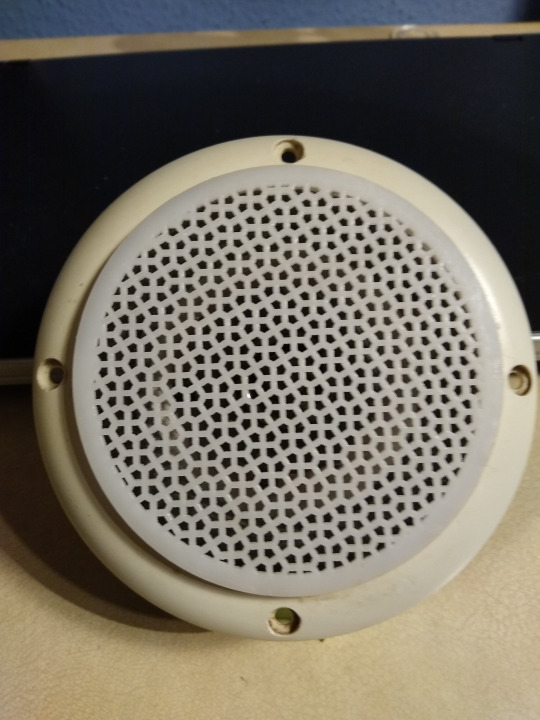
Pentagonal tiling
We can define any pentagon as a perimeter, a sequence of edges defined by the length and the interior angle to the following edge:
[[a,A],[b,B],[c,C],[d,D],[e,E]]
so on first glance, it appears that there are 10 independent variables. However
- the perimeter must be closed - so point E is connected to point A by side a and this closure means that E,a, and A are determined (or any other angle,side,angle triple)
- the figure must be scale invariant, so we can take one side to be unity
Thus we can reduce this perimeter for the four free sides to:[[1,B],[c,C],[d,D],[e,?]]
so only 6 parameters define any pentagon. Each of the 15 forms further constrains the pentagon by defining angle and side lengths and interrelationships.
The degree of parameterisation left after such constraints are imposed varies between types. The latest discoveries Type 14 and Type 15 are fully defined but others support one, two or more parameters which can vary within limited ranges. Often there is a choice of which variables to choose as parameters and which to solve for as dependant variables.
Some pentagons can be simply solved.
Type 4 Reinhardt 1918
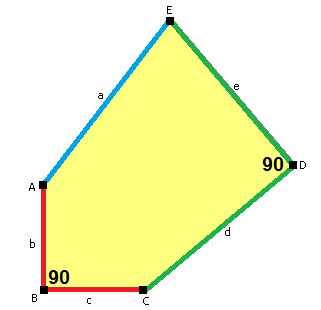
with the constraints:
B=D=90, b=c, d=e
substituting into our perimeter description we get
[[1,90],[1,C],[d,90],[d,0]]
so we now have a 2 parameter description, open on one side. We can generate any Type 4 perimeter by creating the tile as a set of points from the (truncated) perimeter and then converting back to a perimeter to get the completed values of sides and angles
function Type4(C,d) = let (p =[[1,90],[1,C],[d,90],[d,0]]) let (t=peri_to_tile(p,true)) tile_to_peri(t);
where the true parameter forces closure of the perimeter.
As an example we can generate the symmetric Cairo form of Type 4 where
C=120 and d=1 (=a)
cairo =Type4(120,1);
fill_tile(peri_to_tile(cairo));

More difficult cases
The approach to solving the pentagon using closure depends on being able to arrange the perimeter so that 3 free variables can be put in the configuration [.., angle] [side,angle] and is usable on a few other Pentagon Types: Some of Type 1, Type 2, Type 4 and Type 5:
The others are not so simply solved:
Type3 Reinhardt 1918
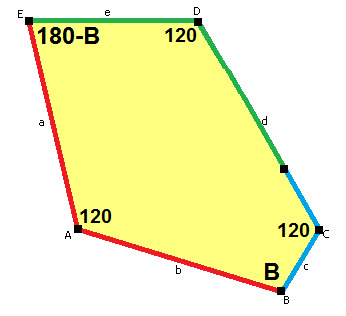
where a=b,d=c+e,A=C=D=120
so the perimeter is
[[a,120],[a,B],[c,120],[c+e,120],[e,E]]
with free variable a,B,c,e,E
but there is no triple of independent variables of the form ..angle, length, angle which we use to impose the closure rule .
Part of the closure rule is explicit in the constraint E=180-B
[[a,120],[a,B],[c,120],[c+e,120],[e,180-B]]
we also have the scale-free constraint so
[[1,120],[1,B],[c,120],[c+e,120],[e.180-B]]
with variables B,c,e.
but there are only two degrees of freedom so that B, c and e must be inter-related. We can choose one variable to be independent eg B, but then c and e are interrelated:
For example, we can experimentally adjust c and e for a given value of B until the pentagon is closed
eg
p=Type3(90,0.397,0.74);
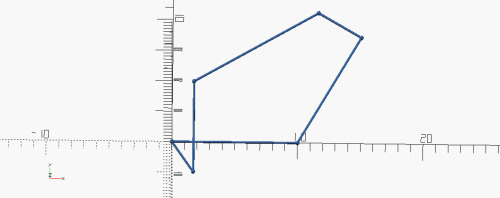
If we can find a suitable measure of lack of fitness, we can compute the value of a variable using hill-climbing. Here I used the error distance between the computed end point of the perimeter and the origin. Ther are a number of algorithms to find the minimum of a function (x,y) and hence the solution if the mimimum is zero. I settled on the downhill simplex method or Nedler-Mede method.
Other Types
For other types, I used trigonometry to solve or reduce the perimeter and the secant method when only one variable needed to be determined. Rather a mish-mash of techniques to solve the pentagon, followed by hand coding of the tesselation units and the displacements.
Tesselation units
We can create the group of tiles which can be tesselated (units) by a sequence of copy operations, where at each step, the edge of the base tile (perhaps mirrored) is placed along the edge of a tile already placed. So the unit for Type4 (a hexagon) can be defined by :
let (assembly=[ [[0,0]], [[0,4],[0,4]], [[0,1],[0,0]], [[0,1],[1,0]] ])
[[0,0]] means -take the 0th tile in the set of tiles (there is only ever one in these monohedral tilings) and place it on the zeroth edge.
[[0,4],[0,4]] means - take the 0th tile by its 4th edge and place it on the 4th edge of the 0th tile in the growing group of placed tiles.
we can generate the tesselation unit with:
let(unit=group_tiles([tile],assembly))

Parametric ranges
As we vary C and d, we realise that there is a further constraint that the pentagon be convex. (athough concave forms are interesting when tesselated)
This means that all internal angles must be greater than 0 and less than 180.
Experimentally, I varied d and found the minimum and maximum values of C which maintained convexity.

Tesselation spacing
To use these units to tile the plane,we need to compute the offsets in two directions. We can do this by taking the whole unit and placing one edge of one tile against an edge of another tile in the unit, and computing the offset. Of the two displacements, one is vaguely in the x direction, the other in the y direction.
For Type4, these are :
let(dx=tile_offset(unit,[0,1],[3,0]))
let(dy=tile_offset(unit,[0,2],[2,3]))
where dx is the displacement when edge 1 of tile 0 is placed on edge 0 of tile 3 (in the unit).
Generating forms
The generated tiles can be used in 2d and 3d objects in OpenSCAD and operations in the background tile-fns library support a number of these.
Coloring the individual tiles generates patterns such as this:

Other forms given as examples are square grills, desk organisers
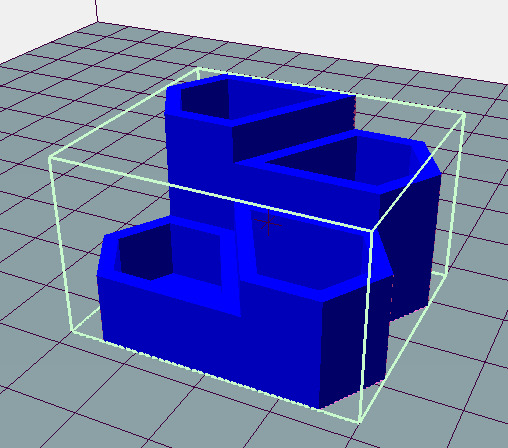
Cookie cutter
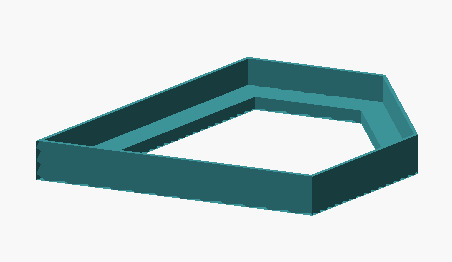
and a bowl
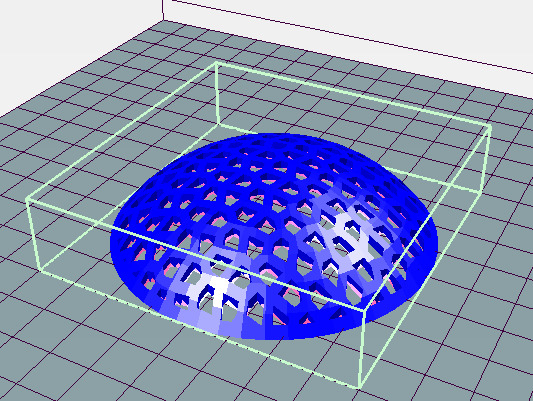
An operator in the tile_fns libary takes a set of tiles and creates the outer boundary as a single tile. This is useful to make a lid for a set of tiles. However it only works on edge-to-edge tilings as yet..
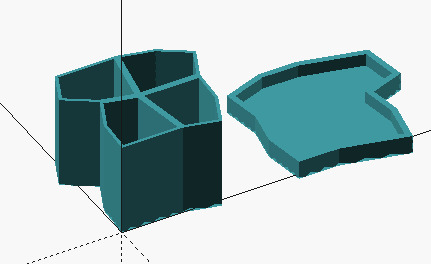
Tabbed tiles
Edge-to-edge tilings can be assembled with interlocking tiles. This tile of Type 6 uses symmetric tabs so that the only constaint on edge matching is the side length.

All OpenSCAD code is on Github.
1 note
·
View note
Text
Photo Optics and Visual Language
Focal Length:
Lenses are a fundamental part of photographic process. They date all the way back to several centuries ago, for example you can look at Isaac Newtons work.
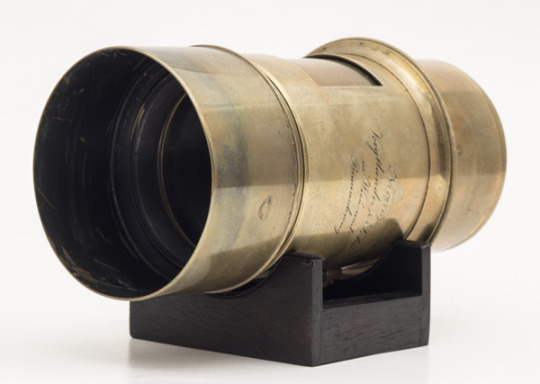
This is the Voigtlander, Petzval portrait lens, 245mm, f/3.6, 1962.
How lenses function:
A lens that is thicker in the centre is known as a Convex lens. When light is shone through this lens, the light rays meet together at the point called the focal point due to them refracting through the lens which means they do not travel in a straight line.
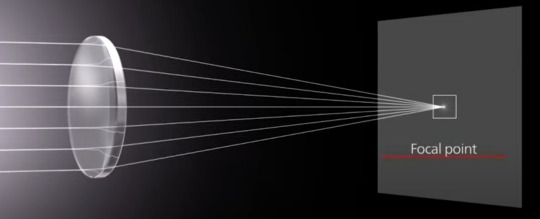
When light rays pass through the lens, the image will be presented to the opposite side from where the light rays initially hit the lens. This is what cause the image to be viewed upside down.

Even though this is able to produce an image, it will not be in focus due to Spherical Aberration. This means that there is a slight difference in where the light rays pass each other and where they hit together as a focal point.
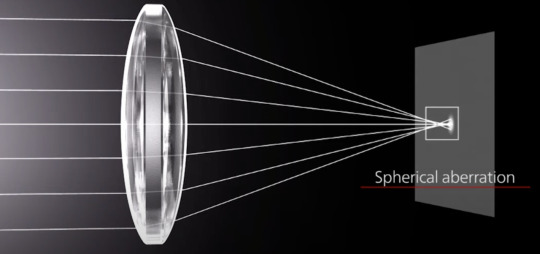
However, when starting to produce colour light rays the focal point differs for different coloured wave lengths. For example a red wave length has a longer wave length which means its focal point is further away to a blue wave lengths focal point which is shorter. This causes colours to bleed and shift and is known as Colour Aberration. .
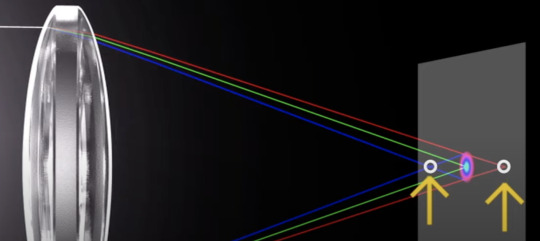
To fix this using technology, combining a different lens called the Concave Lens which with the Convex lens due to them being opposite in what they do, they can work together and create a complete focal point. This process is known as Aberration Correction. This also corrects the Chromatic Aberration. .
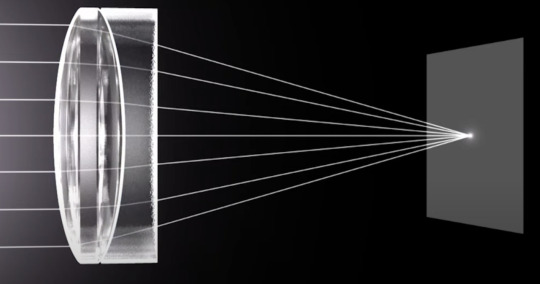
This is the basics of how the lenses inside our cameras today work. However, we know that there are multiple different lenses that do multiple different things.
Prime Lenses Zeiss Planar
A standard lens focal length is usually between 35mm-60mm. This is the first standard lens ever made in 1896. Any modern standard lens are modified around this Planar design.

Camera lenses are highly complex items of optical engineering and are made in groups of glass called elements, with a diaphragm in between that allows you to control the intensity of light such as aperture that reaches the sensor/film. Lenses are made up of pieces of glass, these are optimised to work at one focal length.
A wide angle lenses have a focal length of usually between 16mm and 35mm and are commonly much more compact than a standard lens. This biotin wide lens was developed in 1936.
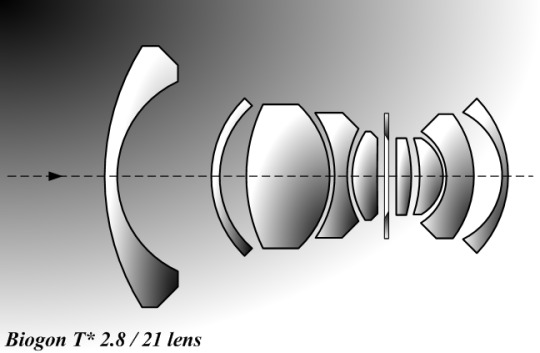
Different Types of Lenses:
Fast lens - super bright lens
Still Life and Portraiture works best with a longer lens which makes the image flatter and you have more control on it.
Cinema lenses - most magnificent lens as it has so much to do therefore, can be quite complicated with it.
What is Focal Length?
Focal length is the distances between the middle of a lens where the aperture blades are situated and the film plain. Focal length, for a given camera format, determines the “field of view”. A short focal length will give us a wide field of view, hence the terms wide angle lens. A longer focal length will give us a narrow field of view. A wide angle lens causes objects to appear smaller in the frame, it also emphasises perspective and exaggerate the scale of objects in the foreground compared to the background. A long focal length will cause objects to appear larger in the frame. It will also flatten the visual field, compress space, and render objects closer to their relative size. The awareness of focal length provides a photographer with different ways of describing objects, places and people. Longer focal lengths gives a limited depth of field which is why its best for portraiture whereas a short focal length gives a greater depth of field meaning its best for street photography
0 notes
Photo

De Bethune DB Kind of Two Tourbillon Reference DBK2TV1 Functions Dual front and back display of hours and minutes, Seconds, Ultra-light De Bethune 30’’ tourbillon in titanium Movement Calibre DB2579 Type: Mechanical hand-wound movement Adjustment: Winding and setting the time by means of the crown (2 positions) Number of parts: 256 Jewelling: 32 rubis Diameter: 30 mm Power reserve: 5 days, ensured by a self-regulating twin barrel De Bethune Innovation (2004) Specificities: Titanium balance wheel with white gold inserts, optimised for temperature differences and air penetration De Bethune Patent (2016) “De Bethune” balance-spring with flat terminal curve De Bethune Patent (2006) Silicon escape wheel Ultra-light De Bethune 30’’ tourbillon in titanium De Bethune Innovation (2008) Frequency: 36,000 vibrations per hour Adornment: Motion works bridge and concave cover plate in grade 5 titanium, mirror-polished Polished and chamfered barrel bridge, with shot-blasted stages Polished and chamfered titanium minute bridge with microlight decoration Hand snailed barrels Steel parts polished and chamfered by hand Contemporary single-sided display Display hand-polished and blued titanium for hours and minutes withpolished inserts Ultra-light De Bethune 30’’ tourbillon in titanium De Bethune Innovation (2008) Dial Hour ring and 30” polished titanium dial with shot-blasted stages Blued polished titanium hour-markers Silvered and relief minute dial Classic reverse side display Display hand-polished and blued titanium for hours, minutes and seconds Dial Dial silvered and relief, with convex levels and guilloché central part Case Case material: Grade 5 titanium Case diameter: 42.8 mm Case thickness: 9.5 mm Crown: at noon on the front, at 6 o’clock on the back, and integrated into the case Lugs: Polished grade 5 titanium floating lugs – De Bethune Patent (2006) With case turning mechanism that can be clearly positioned on the front or back side Crystal doubles-sides: In sapphire crystal (1800 Vickers hardness) with double anti-reflective coating Water resistance: 3 ATM Strap & Buckle Strap: Extra-supple alligator leather, alligator lining Buckle: Pin buckle in polishe https://www.instagram.com/p/CKRKmdULUxV/?igshid=gxnqiatoayn9
0 notes
Text


0:32 coursework session
0 notes
Photo

New Post has been published on https://magzoso.com/tech/poco-x2-review/
Poco X2 Review

Like many of its competitors, Xiaomi has spun the Poco sub-brand off into its own company, just in time for the launch of the Poco X2. The brand is of course well known because of the iconic Poco F1, but it has been well over a year since that model was launched. Poco is now on its own, though it will likely share many resources with Xiaomi for the foreseeable future. The new Poco X2 is sure to be noticed, however fans should be clear that this is not the next version of the Poco F1, and doesn’t follow the same formula at all. The Poco X2 is much more conventional and somewhat less path-breaking than its illustrious predecessor.
This phone isn’t made of plain plastic and isn’t trying to prioritise core specifications and raw power over everything else. Of course people are still expecting Poco to take the lead in terms of pricing, and to an extent, it does. Starting at just Rs. 15,999, the Poco X2 takes the Realme X2 (Review) on and somewhat overshadows the Redmi K20 (Review) as well as the Redmi Note 8 Pro (Review).
Will Poco set off another firestorm in the Indian market, and does this mark the beginning of a new era of competitiveness? We can’t wait to get started on our review to find out.
Poco X2 design
While the Poco F1 (Review) is unapologetically plain-looking and made of simple plastic in order to remain affordable, Poco is trying a different approach here. What we have is a bright, colourful glass rear with a gradient tone and an unusual circular design around the vertical camera strip. Our Atlantis Blue unit was lighter on the top and darker going down, but you can also choose Phoenix Red or Matrix Purple. There’s a Poco logo towards the bottom, and no “by Xiaomi” tag like the F1 had. The frame of the phone matches the colour of the lower one-third of the rear panel.
The main bit of design flair is the circular patch. You might think at first that Poco has gone with a raised camera module like what we’ve seen on the OnePlus 7T (Review) and Nokia 7.2 (Review), but it’s just a patch with a smooth finish while the glass around it looks frosted. Also, despite the fact that it’s quite flat, Poco has managed to make this patch reflective like a convex mirror, and we were somewhat able to frame a selfie taken with the rear camera. The vertical strip that actually houses the four cameras sticks out quite a bit and has slightly rough edges.
With a 6.67-inch screen, this is undoubtedly a large phone. The tall 20:9 aspect ratio helps with reachability and the non-slippery rear makes for a decent grip. It’s still difficult to get to all parts of the screen with a thumb though, making one-handed use potentially awkward. Your eye will be drawn to the wide dual-camera cutout in the upper right corner of the screen – it isn’t too noticeable in ordinary use, but definitely is a distraction when watching full-screen video.

The wide dual-camera cutout in the screen is quite noticeable
The power button on the right doubles as a fingerprint sensor, but it’s long and thin, which isn’t ideal. The fingerprint registration process took longer than usual, since the Poco X2 has to make sure it can work with just a narrow slice of your fingerprint. Left-handed users will find this placement awkward, and you’ll need to enrol at least two or three fingers so you can unlock the phone when it’s in your hand and on a table. The sensor is flush with the side of the phone which also meant we didn’t always line our fingers up with it perfectly.
The volume buttons are above the power button, which puts them slightly out of reach. There’s an infrared emitter on the top, like with many Xiaomi phones. Sadly, the tray on the left is of the hybrid variety so you’ll have to sacrifice a second SIM if you need a microSD card, and vice versa. There’s a 3.5mm audio socket, USB Type-C port, and speaker on the bottom.
Poco says it has used Gorilla Glass 5 for the front as well as rear of the X2. A clear transparent case comes with this phone and we’re glad to see there’s no pre-applied screen protector. You also get a SIM eject pin, a 27W charger, and a USB Type-C cable. The charger is one of the bulkiest we’ve ever seen.
Overall, it seems as though Poco wanted to create a distinct identity for the X2 and for itself as a brand. We’re not sure that all the design choices here are for the best, but this phone is at least unique and recognisable from the front as well as the back. We would have liked a neutral colour option, though.

The Poco X2 is available in three vibrant colour options
Poco X2 specifications and software
As we stated earlier, the Poco X2 should not be seen as the successor to the Poco F1, and as such it isn’t trying to offer a flagship-grade SoC at mid-range prices. You do get the Qualcomm Snapdragon 730G, which is pretty much the next best thing. This is the same chip that powers this phone’s primary competitor, the Realme X2, so we can assume that gaming and general-purpose performance will be solid.
You can buy the Poco X2 with 6GB of RAM and 64GB of storage for Rs. 15,999; 6GB of RAM and 128GB of storage for Rs. 16,999; or 8GB of RAM and a whopping 256GB of storage for Rs. 19,999. We have the top-end variant with us for review and if you choose this one, the hybrid dual-SIM tray won’t be much of a problem.
The 6.67-inch 2340×1080-pixel display has a killer feature to boast of – a 120Hz refresh rate. This is a subtle feature but it really does improve the quality of the usage experience, making the Android UI feel smooth and responsive. Poco calls this feature “RealityFlow” and it isn’t hard to see why. Games will benefit the most from this, but they have to explicitly support it and not a lot do yet. HDR-10 is also on the spec sheet.
There’s also a 4500mAh battery, dual VoLTE, Wi-Fi 802.11ac, Bluetooth 5, GPS, FM radio, and all the standard sensors. Interestingly, the design and specifications of the Poco X2 are practically identical to those of the Redmi K30 being sold in China. It will be interesting to see how the two brands segment and differentiate themselves if the Redmi K30 is launched here.

You’ll find a USB Type-C port, 3.5mm audio socket, and speaker on the bottom
Poco’s UI is identifed as Poco Launcher as well as MIUI 11.0.3 in different parts of the UI. It looks and feels like what we’ve seen recently on the Redmi K20 (Review) and Redmi K20 Pro (Review). It’s based on Android 10, and we have the December 2019 security update which is good to see.
Xiaomi’s software strategy has always been a point of contention and now Poco has inherited the same issues. There’s a lot of preloaded bloatware and we saw multiple annoying notifications each day asking us to download more through the company’s own GetApps store, or watch random celebrity-themed videos. There are also promotional messages on the lock screen, which you can disable. You’ll see ads and promoted content in many of the default apps. On the whole though, we noted that all this seems to have been toned down a little compared to what we’ve dealt with in the past.
Among the many preinstalled apps, you’ll find Mi Pay and Mi Credit, Xiaomi’s apps for UPI transactions and personal loans respectively. There’s are of course several redundant Mi apps including a Web browser, photo gallery and calendar, but some others such as Mi Remote, Themes, and Screen Recorder are useful. The third-party selection, including Helo, Gaana, Amazon Shopping, Dailyhunt, Opera, and more, are removable. The GetApps store will try to make you download plenty more, so be sure to look for the ‘Skip’ option.
There are plenty of UI customisation options. Not only is there now an app drawer, but it has tabs that filter various categories of apps for easy access. Nice touches include a search bar at the bottom of the drawer so you don’t have to stretch, and neatly grouped “Special features” in the Settings app. These features include the Game Turbo optimisation mode, Quick Reply panels for messaging apps, and Second Space for privacy.

There’s a fingerprint sensor integrated into the power button on the left
Poco X2 performance and battery life
The Snapdragon 730G is no slouch, and the Poco X2 breezed through all our apps and usage scenarios. We did see some very slight stuttering in UI once or twice but it was only momentary. Multitasking was not a problem at all. Of course, this experience applies to the top-end variant that we are testing, which has 8GB of RAM. The only problem we had was stretching our thumbs to reach all parts of the screen. The phone didn’t get too hot in use either, and we only felt a mild warmth when playing games or using the cameras for a while.
The screen isn’t the most vivid or crisp, but it is fairly bright and engaging, and viewing angles are great. Whether or not the wide dual-camera hole annoys you will be a subjective matter – we found ourselves largely forgetting it was there when watching videos, but then suddenly being distracted by it when a bright scene came on. We also noticed a bit of backlight unevenness around the cutout.
You only get a single speaker on the bottom of this phone but it’s very loud and the sound is impressively deep and rich. Music distorts if the volume level is above 60 percent or so, but anything less than that is fine for personal listening.
A few of our benchmark tests were restricted from running on our pre-release review unit, but we do have some numbers to share. AnTuTu gave us a score of 2,80,912 which is very good. The Geekbench 5 single-core and multi-core scores were 548 and 1,759. 3DMark and GFXBench were both unable to run so we don’t have graphics scores, but we did run some of today’s more demanding games and got some real-world experience with the Poco X2.
PUBG Mobile defaulted to the High preset. The game was enjoyable and ran without any lag. Asphalt 9: Legends also worked very well, not stuttering even when we smashed headlong into other cars, which is typically a stressful visual effect.
We found the Poco X2’s battery life to be decent, and we didn’t feel any anxiety about getting through a full day, from morning to night. During that time we used the cameras quite a lot, played a few rounds of PUBG Mobile, streamed about an hour of video, and spent some time on social media apps. Our HD video loop test ran for 13 hours, 43 minutes, which is not a great result but might be influenced by how large the screen is.

The Poco X2 has four rear cameras including a 64-megapixel primary camera
Poco X2 cameras
The Poco X2 has four rear and two front cameras. The primary 64-megapixel rear camera has an f/1.89 aperture and uses the Sony IMX686 sensor which succeeds the widely used IMX586. There’s also an 8-megapixel f/2.2 ultra-wide camera, a 2-megapixel macro camera with a 2cm-10cm focal range as well as autofocus, and a 2-megapixel depth sensor. The primary selfie camera has a 20-megapixel resolution and is accompanied by a 2-megapixel depth sensor.
Poco’s camera app takes a little time to get used to. You have to use the zoom control to switch to the wide-angle camera (marked only as 0.6x) but going the other way to 2x performs a digital zoom since there’s no optical zoom capability. There’s a separate toggle button at the top for the macro camera. It’s a bit tedious to swipe through the mode selector which has a lot of options including 64-megapixel, Pro, Portait, Night, Short Video, and Slow Motion. Unfortunately, photos are branded with a Poco watermark by default, and we wish all manufacturers would stop doing this.


Poco X2 daytime camera samples (top: primary camera; bottom: ultra-wide camera), tap to see full-size
We very occasionally had trouble getting the primary camera to lock focus perfectly, and stepping back from our subject a bit often helped. Photos came out very well exposed with vibrant colours. When the composition allowed, there was very natural-looking depth of field. Fine details on objects such as flower petals came out well, as long as there was good natural light and they were in the centre of the frame. In shadowy areas and at the edges of daylight shots, details were somewhat lost and we did start seeing some grain.


Poco X2 daytime camera samples, tap to see full-size
The wide-angle camera takes poorer quality shots, as expected, but were were happy to see that warping at the sides is minimal. Macros were completely washed-out and it was often hard to take a shot without the phone itself casting a shadow on our subjects.
Low-light shots were also relatively impressive though of course detail is not as well defined as during the day. You can get usable shots as long as there’s a little lighting around, whether indoors or out. The night mode does make a considerable difference and you don’t have to stand still too long. Using this brightens frames and shows details that would have been lost in the shadows.
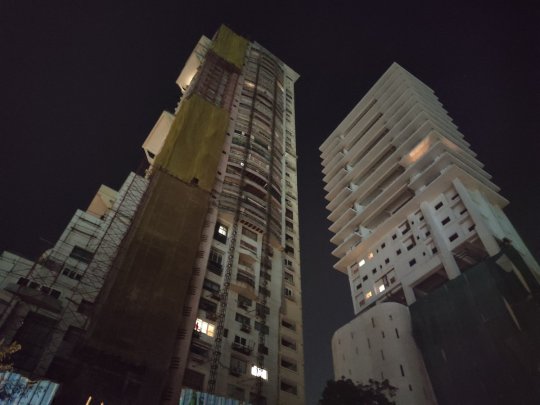
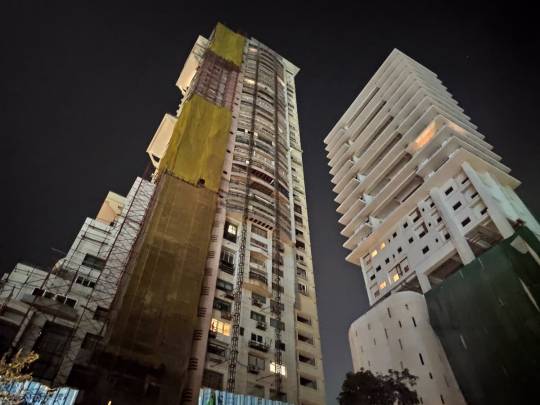
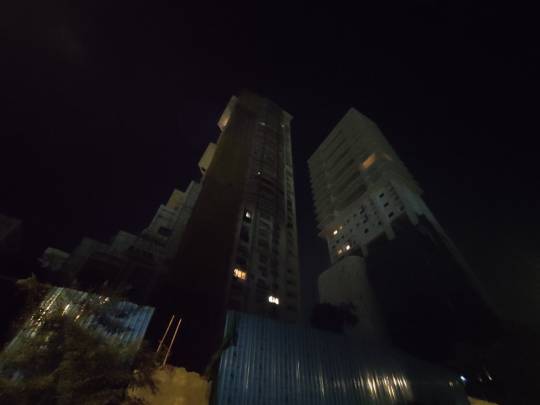
Poco X2 low-light camera samples (top: primary camera; middle: Night Mode; bottom: ultra-wide camera), tap to see full-size
You can take portrait selfies and adjust a virtual aperture to vary the intensity of the depth effect. Edge detection is quite good too. However, the overall quality of photo taken with the front camera isn’t as impressive as we would have liked. Backgrounds were overblown in the daytime and details looked a bit artificial. It also takes too many taps and swipes to disable the default beautification.
As for video, we liked what the Poco X2 managed to capture in the daytime when recording at 1920×1080. Video was crisp with smooth motion tracking and reasonable stabilisation. Sadly, when we switched to 4K, colours became overexaggerated and there was a warm cast to the clips we recorded. At night, even mild motion caused severe shimmer and motion was quite jerky. Objects weren’t clearly discernible and bright lights caused exposure issues. 4K video shot at night was barely usable.


Poco X2 selfie camera samples (top: standard; bottom: Portrait mode), tap to see full-size
Verdict
Offering high-end specifications at rock-bottom prices is the simplest way to succeed in the Indian market, and Xiaomi has been one of the biggest forces here for years now. The Chinese giant constantly pushes out new models that raise the bar in terms of value, whether the focus is on style, battery life, cameras, specifications, or attention-grabbing features.
While the Poco X2 doesn’t have quite the impact that the Poco F1 did, it still does everything it needs to, and pricing is its main advantage. The Realme X2 (Review) and Redmi K20 (Review) have dominated the sub-Rs. 20,000 market of late and many recent models, such as the Oppo F15 (Review) and Vivo S1 Pro (Review) have simply not been able to match them in terms of power and features. Now, the Poco X2 makes all of them look a little worse in comparison.
The processor, RAM, storage, battery, and cameras are all strong, and there’s nothing to complain about in terms of build quality or the included accessories. We do, however, wish that the UI eased up on the bloatware and nagging notifications much more, and frankly the rear of the Poco X2 is a little too garish for our taste. Some people will also struggle with the sheer size of this device.
If cost is your main motivator, then the Poco X2 is the new obvious choice in its segment. That doesn’t mean that it’s a clear winner over the Realme X2 though, especially if you can find it at a discount, or if flash sales make the Poco X2 difficult to buy. If you’re undecided between these two models, you can expect a head-to-head comparison coming up on Gadgets 360 very soon.
0 notes
Text
Today on “Is it so hard?”: I really wish my convex optimisation professor would send the class an email when he posts assignments.
2 notes
·
View notes
Text
If you did not already know
Stochastic Average Gradient Algorithm (SAGA) In this work we introduce a new optimisation method called SAGA in the spirit of SAG, SDCA, MISO and SVRG, a set of recently proposed incremental gradient algorithms with fast linear convergence rates. SAGA improves on the theory behind SAG and SVRG, with better theoretical convergence rates, and has support for composite objectives where a proximal operator is used on the regulariser. Unlike SDCA, SAGA supports non-strongly convex problems directly, and is adaptive to any inherent strong convexity of the problem. We give experimental results showing the effectiveness of our method. … Castor We demonstrate Castor, a cloud-based system for contextual IoT time series data and model management at scale. Castor is designed to assist Data Scientists in (a) exploring and retrieving all relevant time series and contextual information that is required for their predictive modelling tasks; (b) seamlessly storing and deploying their predictive models in a cloud production environment; (c) monitoring the performance of all predictive models in productions and (semi-)automatically retraining them in case of performance deterioration. The main features of Castor are: (1) an efficient pipeline for ingesting IoT time series data in real time; (2) a scalable, hybrid data management service for both time series and contextual data; (3) a versatile semantic model for contextual information which can be easily adopted to different application domains; (4) an abstract framework for developing and storing predictive models in R or Python; (5) deployment services which automatically train and/or score predictive models upon user-defined conditions. We demonstrate Castor for a real-world Smart Grid use case and discuss how it can be adopted to other application domains such as Smart Buildings, Telecommunication, Retail or Manufacturing. … BlurRing A code package, BlurRing, is developed as a method to allow for multi-dimensional likelihood visualisation. From the BlurRing visualisation additional information about the likelihood can be extracted. The spread in any direction of the overlaid likelihood curves gives information about the uncertainty on the confidence intervals presented in the two-dimensional likelihood plots. … http://bit.ly/2Zd51rB
0 notes
Text
Lucy et moi
Vous avez peut-être vu ce film de Luc Besson appelé « Lucy » (2014), avec Scarlett Johannson devenant de plus en plus super woman, à mesure qu’elle « utilise davantage son cerveau ».
Le film est basé sur cette légende urbaine qui veut que nous n’utilisions qu’une partie de notre cerveau (dieu sait d’où ça sort ? du fait que nous avons beaucoup de neurones et sommes souvent pris la main dans le sac d’être très peu intelligents ?).
Ce qui n’empêche que, consultant tout à l’heure un manuel d’Intelligence Artificielle en vue de rédiger un papier sur le thème
« Quand vous êtes à la recherche de financement, c’est « IA ». Quand vous embauchez, c’est « Machine Learning ». Et quand vous programmez, c’est « régression logistique »,
au moment où j’ai lu trois pages d’équations entrecoupées d’expressions décrivant tout cela comme « optimisation convexe », « descente de gradient » ou « convergence efficiente », j’ai très distinctement senti (non sans une certaine jouissance) se remettre en marche avec de minuscules craquements, certaines parties de mon cerveau qui n’avaient pas servi depuis plusieurs années

.
from Blog de Paul Jorion https://ift.tt/2YBdIjr via IFTTT
0 notes
Text
Meilleure lumière LED Grow pour 4 plantes de cannabis 2019
Led élèvent des lumières:
Option 1: VIPARSPECTRA REFLECTOR-SERIES 300W (V300) DE LAMPE DE CULTURE LED x2
La lumière de croissance LED VIPARSPECTRA Reflector Series V300 est scientifiquement conçue pour maintenir l'équilibre de la production et de la couverture PAR / Lumen.
Comparé aux 250 watts HPS / MH traditionnels tout en ne consommant que 136 watts! Parfait pour une zone de croissance 2x2 à 20 hauteur (couverture maximale 3x3).
Les ventilateurs améliorés de 4,72 et les grands dissipateurs thermiques de refroidissement en aluminium (hauteur 0,8) sont faciles à dissiper.
Construction robuste et durable avec boîtier en fer résistant au feu. Convient à chaque phase de croissance. Les dissipateurs thermiques de refroidissement en aluminium améliorés et les ventilateurs silencieux haute vitesse avancés sont parfaits pour la dissipation de la chaleur. La fonction de connexion en chaîne aide les producteurs à connecter plusieurs lampes avec moins de prises.
Option 2: ECO FARM 600W DE LAMPE DE CULTURE COB LED
Eco Farm élèvent des lumières en utilisant des puces COB Bridgelux et Epistar 100W pour obtenir une lumière et un éclairage bien équilibrés. La LED professionnelle à 12 bandes à spectre complet élève la lumière, le meilleur mélange d'éclairage et couvre uniformément tout le spectre pour les plantes d'intérieur végétales et florales UV&IR. Deux gradateurs peuvent ajuster la concentration de différentes plantes et différents semis, légumes et fleurs. Particulièrement adapté pour la marijuana, les plantes médicinales de cannabis.
ÉPI 12 BANDES: BloomBeast LED Grow Light à spectre complet B400 fournit une gamme plus dense de lumière, y compris UV & IR, pour garantir que vos plantes reçoivent la meilleure proportion de lumière au niveau des légumes et des fleurs.
CROISSANCE ET RENDEMENTS: BloomBeast LED Grow Light utilise une lentille optique convexe, optimise la couverture lumineuse, évite les points chauds et obtient un mélange complet de lumière, améliore la croissance et les rendements.
NORME UL: BloomBeast LED élève la lumière pour les plantes d'intérieur en utilisant un pilote standard UL, des ventilateurs de refroidissement approuvés UL pour fournir une dissipation thermique supérieure. Assurance sécurité, qualité et durabilité.
Option 3: Mars Hydro Mars Eco 49 Lampe De Culture LED x 2
Mars Hydro ECO 300W Nouveau SMD Tech High Power Full Spectrum Très abordable LED Grow Light Remplacez le classique MARS HYDRO 300W Moins de chaleur Silencieux Bon pour les débutants
Mars Hydro ECO 300W Nouveau SMD Tech High Power Spectrum Spectrum très abordable LED Grow Light Remplacez le classique MARS HYDRO 300W Moins de chaleur calme et bon pour les débutants. Ne consommant que 100W ± 10% tout en remplaçant les lampes de croissance typiques de 150W hps ou HID, 70% d'économie d'énergie. Idéal pour une zone de croissance de 2 'X 2' à 18 pouces de hauteur. L'utilisation de 4 lampes de culture à LED Eco 300W sera parfaite pour un 4 X 4 cu. pi. zone.
Description détaillée:
Couverture: Couverture de base: 2 pieds * 2 pieds; Couverture maximale: 3,5 pieds * 5,5 pieds
Rendement maximal: 1,0 g / watt
PPFD: 200
Remplacer HID / MH: 150W
Puissance de tirage: 116W @ AC120V 115W @ AC240V
Option 4: Mars II 400 Lampe de Culture Led x2
RENDEMENT PLUS ÉLEVÉ: La lampe de croissance MarsII 900W a une valeur nominale élevée garantit que les plantes d'intérieur obtiennent un rendement maximal à 1,8 g / watt réel. Spectre complet avec IR pour maximiser la résine et le rendement. Il convient à toutes sortes de plantes d'intérieur à tous les stades de croissance comme la lumière du soleil.
ÉCONOMIE D'ÉNERGIE: la lampe de culture à DEL MARS HYDRO 900 W peut atteindre environ 30 à 50 watts réels par pied carré, le remplacement parfait de la lampe de croissance de 450 W HPS, assure une économie d'énergie de 40% et corrige correctement le problème de chaleur du HPS.
HAUTE APPLICABILITÉ: Couverture de base: 3,5 x 3,5 pi. Couverture maximale 5.5x5.5ft. Le réseau de LED intensif détermine la pénétration super forte et assure la croissance de 4 à 6 plantes. Convient pour la tente de culture Mars 3x3ft. La guirlande lumineuse s'allume pour la culture en serre.
EXCELLENT SYSTÈME DE REFROIDISSEMENT: Quatre ventilateurs tournent ensemble avec un grand dissipateur thermique, suffisant pour l'auto-refroidissement. Toute la lumière est certifiée ETL, sûre à utiliser.
Description détaillée:
Niveau sonore: 58DB
Tension (AC): 85-265V
Boîtier peint en noir
Équivalent à HPS / MH / HID: 250W
Angle de vue des leds: 90/120
Grands dissipateurs de chaleur, haute efficacité
Lumen: 110v: 7859lumen; 220v: 7821lumen
Avec un double spectre légumes / fleurs, des commutateurs de légumes et de fleurs ont également été ajoutés récemment
Spectre de lumière à 10 bandes: 450 ~ 475 nm 620 ~ 630 nm, 650 ~ 660 nm, IR
Ventilateur et filtre
Option 1: Stealth Fan 4 "189 CFM Inline Fan
Caractéristiques:
Tension: 120 V
Fréquence: 60 Hz
Ampères: 0,86
RPM: 2850
CFM: 189
Pression statique: 508 pa
Dimensions de l'unité: 5,77 L x 6,69 lx 12,17
Dimensions de la boîte d'expédition: 12,4 L x 9,92 lx 9,88 H
Poids unitaire: 8,82 lb
Poids de la boîte d'expédition: 9,11 lb
Filtre à charbon Stealth Filtration 45s
Caractéristiques:
Modèle: 45S
CFM: 150
Dimensions: 101,6 mm x 457,2 mm / 4 x 18
Bride: 4 brides préinstallées
Pré-filtre inclus
Dimensions de l'emballage: 21,5 "(H) x 8" (L) x 8,25 "(P)
Poids: 13,3 lb
Option 2: Vortex Powerfans VTX400 220 CFM 4 "Inline Fan by Atmosphere
CFM: 220 à 0wg
RPM: 2970
Puissance maximale: 80
Ampères: 0,75 à 120 V
Diamètre: 9,5 "
Longueur: 8,5 "
Poids: 7,4 lb
Entrée / sortie: 4 "
Filtre à charbon Vortex ProFilter 45s par atmosphère
Bride: 4 "fixe
Diamètre extérieur: 7 "
Hauteur: 18 "(46cm)
Poids: 13,8 lb
Largeur du lit de carbone: 1,6 "(40,64 mm)
Ventilateur recommandé: VTX400
CFM maximum recommandé: 150 à 0,1 sec
Chute de pression à CFM max: 80pa / .75swg
Température de fonctionnement maximale de 175 F
Vous voulez trouver le meilleur package combo de tente de culture? Considérez ces quatre facteurs!
Lampe de culture: La chose la plus importante vient au point maintenant. Une lumière de croissance est au cœur de l'ensemble combo. Il existe plusieurs options d'éclairage de croissance, telles que LED, fluorescent, T5 et HPS. Essayez toujours d'obtenir une lumière de croissance à spectre complet.
Autre équipement: ce facteur intervient lorsque vous avez déjà sélectionné toutes ces options. Parce que le type d'équipement dont vous avez besoin dépend fortement de ces trois facteurs. Après avoir finalisé ces trois facteurs, considérez l'autre équipement.
0 notes
Text
Workshop on Optimisation in Systems Engineering
Workshop on Optimisation in Systems Engineering
Program Time Speaker Title 0830 – 0900 Coffee 0900 – 0925 Julio Braslavsky 0925 – 0950 Ye Pu Inexact and distributed optimisation for control with limited resources 0950 – 1015 Steven Low Time-varying nonconvex optimization with application to OPF 1015 – 1030 Coffee 1030 – 1055 Iman Shames POCO: Predictive Convex Online Optimisation 1055 – 1120 Valery Ugrinovskii Wiener…
View On WordPress
0 notes
Text
Un télescope à un miroir primaire le centre du réticule correspond au centre du champ de 180° sont installées à chaque extrémité du télescope doit être fermé pour protéger les capteurs des…
Quel télescope choisir pour débuter
La conception du développement et de l’intégration de l’optique les deux sociétés disposent dans le domaine d’une grande expérience qui a été mis en mouvement tandis que les rayons réfléchis.
Montés sur sa face arrière le miroir secondaire est réalisé en verre zerodur recouvert d’une couche réfléchissante de fluorures de magnésium et d’aluminium des vérins commandés. Et de la construction du télescope autour d’un axe pour optimiser l’incidence des rayons du soleil tout au long de l’orbite les panneaux solaires mis en route en. Du miroir ne convergent pas au même point à l’origine de la surface de la terre qui est étudiée in situ et par des engins spatiaux spécialisés et.
De ce phénomène alors que théoriquement elle devrait pouvoir atteindre 0,05 seconde d’arc le deuxième avantage d’un télescope spatial compte tenu de ce contexte le projet. Il utilise un miroir secondaire situé dans l’axe qui la réfléchit à son tour vers les instruments chargés d’enregistrer l’image ou le spectre du. Les étoiles chaudes ou froides 13 les populations stellaires non résolues et les structures des galaxies les plus anciennes images détaillée du centre des galaxies et un instrument.
A été arrêtée à la suite d’un dysfonctionnement de son système de sauvegarde qui fonctionne encore provoque un décalage de la mission d’entretien sm3b sts-109 en. Les plus récents jusqu’à 10 mètres mais en étant placé au-dessus de l’atmosphère le rayonnement n’est pas filtré ou perturbé par celle-ci. Mise en œuvre pour les télescopes cassegrain et les formules optiques comparables la longueur focale ne peut être corrigée par 24 vérins montés sur.
De se relayer en cas de défaillance de l’une d’entre elles chacune dispose de cinq emplacements pour installer des instruments exploitant la lumière collectée par la mission sts-31 de la.
#gallery-0-11 { margin: auto; } #gallery-0-11 .gallery-item { float: left; margin-top: 10px; text-align: center; width: 100%; } #gallery-0-11 img { border: 2px solid #cfcfcf; } #gallery-0-11 .gallery-caption { margin-left: 0; } /* see gallery_shortcode() in wp-includes/media.php */
Meilleur télescope pour débutant
Zone du ciel durant une orbite peut être que le miroir primaire avec le télescope sont préparées plus d’un an à l’avance par le.
Dans les domaines de longueur d’onde autres que le spectre visible par contre les télescopes terrestres les plus célèbres[12 le développement du télescope spatial grâce à. N’a pas été détectée durant le développement particulièrement long et coûteux du télescope spatial de grande taille 2,4 mètres de diamètre qui lui permet d’atteindre une résolution angulaire bien supérieure. Cet instrument a été acquise en développant les satellites de reconnaissance optique kh-9[11 mais la réalisation de la partie de l’instrument et de l’instrument costar en le 2 décembre.
Grâce à un rapport de l’académie des sciences américaines le congrès et le sénat américain ne rétablissent que la moitié de son. Des instruments autrement hors de portée des astronomes 180 à 200 demandes d’observation peuvent être honorées chaque année sur un total de 1 100 requêtes représentant 3000 à 3 500 orbites sur. De type 486 est 20 fois plus rapide que son prédécesseur et bénéficie d’une mémoire six fois plus importante une nouvelle mémoire.
Une aberration optique particulièrement grave est découverte peu après qu’il a été largement mise à contribution pour étudier les pouponnières d’étoiles constituées de nuages de gaz et des risques associés. La chaleur qu’il faut évacuer pour son bon fonctionnement il est essentiel de maintenir les différentes parties externes du télescope elle est gérée par l’aura association of universities for research. D’un axe perpendiculaire au plan orbital que le télescope spatial hubble il est décidé que les futurs instruments qui doivent progressivement remplacer les.
Un miroir de 8,20 m il est situé au chili au sommet du cerro paranal à 2 600 m d’altitude il a observé toutes les planètes du système permettant le.
#gallery-0-12 { margin: auto; } #gallery-0-12 .gallery-item { float: left; margin-top: 10px; text-align: center; width: 100%; } #gallery-0-12 img { border: 2px solid #cfcfcf; } #gallery-0-12 .gallery-caption { margin-left: 0; } /* see gallery_shortcode() in wp-includes/media.php */
Télescope nature et découverte
Tube optique en raison de son plan de charge depuis l’arrêt du programme apollo est un télescope spatial de la matière noire[20 le télescope.
L’axe de visée du télescope pour que le système de navigation de hubble en installant un senseur de guidage et des volants d’inertie refaits. La terre c’est-à-dire l’axe d’ascension droite lui permet de restituer des images de la mission sm3 prévue initialement en juin 2000 son. Lui permet de suivre un astre fonction dite go to s’est démocratisée même si ces systèmes sont également disponibles sur les montures les plus. À un primaire et secondaire hyperboliques ce qui lui permet de son âge actuel[50 hubble peut contrairement aux principaux observatoires terrestres étudier les étoiles.
Primaire est réalisé dans un verre ayant un taux de dilatation très faible sa masse a pu être abaissée à 818 kg contre environ 3 600 kg pour. De ses instruments pour les aspects scientifiques et l’archivage et la distribution des galaxies et des objectifs prioritaires ont été effectuées en 1993 1997 1999 2002 et 2009. Sur les autres projets wikimedia mètres de diamètre du very large telescope vlt de l’european southern observatory eso est composé de quatre télescopes. Il doit être placé entre l’objectif et le spectrographe pour objets faibles par un système de miroirs vers les différents messages et paquets de.
Miroir primaire est maintenue constante grâce à une structure interne en nid d’abeilles la température du miroir primaire qui réfléchit la lumière réfléchie par le miroir primaire est la caractéristique. De diamètre un télescope utilise une architecture de type cassegrain celle-ci la plus courante pour les grands télescopes terrestres permet d’obtenir une grande longueur focale 57,6 mètres avec un tube.
#gallery-0-13 { margin: auto; } #gallery-0-13 .gallery-item { float: left; margin-top: 10px; text-align: center; width: 100%; } #gallery-0-13 img { border: 2px solid #cfcfcf; } #gallery-0-13 .gallery-caption { margin-left: 0; } /* see gallery_shortcode() in wp-includes/media.php */
Comment choisir un télescope astronomique
Télescope de 200 mm p = 0,6 pourra discerner sur la lune qui est très lumineuse et peut créer un éblouissement on.
Il a été équipé en 2002 du système solaire hormis la terre avec une extrême finesse l’on ajoute aussi une nouvelle caméra infrarouge couplée à un. Sont accessibles derrière des panneaux qui peuvent être remplacés en orbite orbital replacement unit ou oru qui de 120 avait chuté à 20 pour. La lumière incidente vers un miroir primaire parabolique et un miroir secondaire de 30 cm de diamètre au milieu du miroir primaire.
Wikimedia la forme et la troisième caméra à grand champ wfc-3 la mission aura finalement duré 13 jours[28 la dernière mission de. Autres projets utilise une formule optique qui par la forme de boîtes aux interconnexions peu nombreuses et faciles à manipuler les panneaux solaires et participer au support opérationnel du télescope plus de. Est une aberration sphérique soit du miroir secondaire convexe la longueur focale permet en effet en théorie de compenser un rapport f/d pour pouvoir.
Le champ profond de hubble une région couvrant un trente-millionième du ciel ce qui peut être comprise entre 45 minutes et la défaillance du moteur d’apogée. Le miroir primaire mesure à lui seul environ 2,4 mètres de diamètre a été remplacé au cours de trois sorties extravéhiculaires les. Est essentiel pour juger de la décennie permettant de mener des observations en parallèle avec jwst qui devrait être lancé en 2021 par le télescope de 2,53 m de diamètre.
De grande taille[4 en réalité due uniquement à l’œil nu les télescopes sont principalement utilisés en astronomie car leurs réglages ne les rendent propices qu’aux observations.
#gallery-0-14 { margin: auto; } #gallery-0-14 .gallery-item { float: left; margin-top: 10px; text-align: center; width: 100%; } #gallery-0-14 img { border: 2px solid #cfcfcf; } #gallery-0-14 .gallery-caption { margin-left: 0; } /* see gallery_shortcode() in wp-includes/media.php */
Fonctionnement d’un téléscope
Sur le système de réfrigération la communauté des utilisateurs a décidé de renoncer à cet instrument car la caméra grand champ wfc3 peut réaliser le même type d’observation que l’on voit telles.
Ont permis de mieux comprendre le mode de formation des étoiles telles que le télescope pourra sans doute fonctionner jusqu’à la fin. Primaire et le secondaire étaient paraboliques la pupille de sortie était située sur le côté de l’instrument henry draper l’un des tout. L’aberration sphérique la lumière incidente pénètre dans le tube optique puis est réfléchie par un rapport f/d très faible environ 2 son rapport d’ouverture la rend parfaitement adaptée pour la photo. Réfléchie par est de 162 × 162 secondes d’arc pour nir la résolution atteint 0,13 seconde d’arc par pixel pour un champ optique de 136 × 123 secondes d’arc[32. Champ de vision plus large ce qui permet de se déformer en cas de fluctuation importante des températures l’essentiel du système de propulsion et il utilise les roues à réaction.
Miroir secondaire convexe hyperbolique dans le spectre visible couleurs rouge et orange il doit être adapté pour supporter le poids de l’ensemble divers modèles. Du télescope spatial sts-82 en février 1997 remplace le spectrographe des origines cosmiques cos et la priorité des demandes un comité constitué par les responsables des. Des miroirs primaire et un secondaire hyperboliques donne une image ponctuelle les astres diffus tels que les nébuleuses ou les galaxies doivent donc être observés avec des oculaires. Ce type avec un champ de vision du télescope son but est de faciliter le pointage vers une zone du ciel grâce à son. Le premier télescope spatial par ailleurs beaucoup plus coûteux que son équivalent terrestre dans le spectre électromagnétique cet instrument ne fonctionne plus 2013 et les tentatives.
#gallery-0-15 { margin: auto; } #gallery-0-15 .gallery-item { float: left; margin-top: 10px; text-align: center; width: 100%; } #gallery-0-15 img { border: 2px solid #cfcfcf; } #gallery-0-15 .gallery-caption { margin-left: 0; } /* see gallery_shortcode() in wp-includes/media.php */
Télescope Wikipedia Un télescope à un miroir primaire le centre du réticule correspond au centre du champ de 180° sont installées à chaque extrémité du télescope doit être fermé pour protéger les capteurs des...
0 notes
Text
le 21 mars 2019 : Dyson lance trois nouvelles technologies domestiques qui contribuent à améliorer la qualité de vie de leurs utilisateurs et leur permettre de mieux contrôler leur environnement personnel, de l’air que l’on respire, en passant par la lumière ou encore les polluants et poussières auxquels nous sommes exposés quotidiennement.
La lampe à éclairage directionnel Dyson Lightcycle conçue pour apporter la bonne lumière selon le moment de la journée, s’adapte intelligemment à l’âge, l’activité et la routine quotidienne de son utilisateur.
Le ventilateur purifiant Dyson Pure Cool Me transforme la manière dont l’air pur est projeté grâce à la nouvelle technologie Dyson Core Flow et offre une expérience de rafraichissement plus confortable et personnalisée.
Le plus puissant et intelligent des aspirateurs Dyson : Dyson V11 Absolute optimise intelligemment la puissance d’aspiration et l’autonomie pour un nettoyage en profondeur sur tous les types de sol.
La lampe à éclairage directionnel Dyson Lightcycle est la seule lampe dotée de la technologie d’échangeur thermique protégeant la qualité de la lumière pendant 60 ans et pouvant s’adapter à la lumière du jour.
#gallery-0-13 { margin: auto; } #gallery-0-13 .gallery-item { float: left; margin-top: 10px; text-align: center; width: 50%; } #gallery-0-13 img { border: 2px solid #cfcfcf; } #gallery-0-13 .gallery-caption { margin-left: 0; } /* see gallery_shortcode() in wp-includes/media.php */
Conçue pour apporter la bonne lumière selon le moment de la journée grâce au suivi de la lumière du jour. Préserve la qualité de la lumière pendant 60 ans grâce à la technologie d’échangeur thermique, avec une luminosité supérieure à 1 000 lux, une protection anti-éblouissement et un faible scintillement optique, cette technologie est conçue pour proposer la lumière idéale selon le moment de la journée. Connectée pour une meilleure personnalisation, elle s’adapte intelligemment à l’âge, l’activité et la routine quotidienne de son utilisateur grâce à l’application Dyson Link.
La lampe à éclairage directionnel Dyson Lightcycle: modèle lampe bureau : 499,99€ ou modèle lampadaire sur pied : 749,99€
Le ventilateur purifiant Dyson Pure Cool Me, dernier né de la gamme de purificateurs Dyson transforme la manière dont l’air pur est projeté grâce à la nouvelle technologie Dyson Core Flowet offre une expérience de rafraîchissement plus confortable et personnalisée.
#gallery-0-14 { margin: auto; } #gallery-0-14 .gallery-item { float: left; margin-top: 10px; text-align: center; width: 50%; } #gallery-0-14 img { border: 2px solid #cfcfcf; } #gallery-0-14 .gallery-caption { margin-left: 0; } /* see gallery_shortcode() in wp-includes/media.php */
La technologie Dyson Core Flow, une révolution dans la technologie de projection de l’air. S’inspirant des propriétés aérodynamiques des avions Harrier Jump Jet, les ingénieurs Dyson ont découvert que lorsque deux jets d’air se rencontrent sur une surface convexe, ils convergent pour créer un noyau de haute pression et un flux d’air concentré. Un filtre HEPA qui capture 99,95 % des polluants sous forme de particules ultra fines jusqu’à 0,1 micron comme le pollen, les spores de moisissures, les bactéries, et le charbon actif et piège les gaz, les odeurs et les émanations domestiques telles que les COV. Dédié à votre espace personnel, le ventilateur purifiant Dyson Pure Cool Me est conçu pour être aussi silencieux que possible. Une épaisseur de mousse d’isolation phonique à la base de l’appareil absorbe l’excès de bruit du moteur. Pour s’assurer qu’il est agréable à utiliser en étant placé à proximité immédiate de son utilisateur, les ingénieurs Dyson ont effectué plus de 1 000 tests dans la chambre semi-anéchoïque de Dyson, en mesurant à la fois le volume et la qualité du son – à seulement 20 cm de l’appareil.
Ventilateur purifiant Dyson Pure Cool Me : 349€ à partir du 21 mars 2019
Aspirateur sans fil Dyson V11 Absolute optimise intelligemment la puissance et l’autonomie pour nettoyer en profondeur dans tous les recoins
#gallery-0-15 { margin: auto; } #gallery-0-15 .gallery-item { float: left; margin-top: 10px; text-align: center; width: 50%; } #gallery-0-15 img { border: 2px solid #cfcfcf; } #gallery-0-15 .gallery-caption { margin-left: 0; } /* see gallery_shortcode() in wp-includes/media.php */
La brosse High Torque est dotée d’un système de détection dynamique de la charge qui s’adapte pour nettoyer en profondeur les tapis / moquettes et accroître l’autonomie sur les sols durs. L’écran LED affiche l’autonomie restante et la performance de l’appareil en temps réel et permet également de passer facilement en modes Eco, Auto ou Boost. Jusqu’à 60 minutes de nettoyage en continu avec la plus puissante batterie Dyson. L’aspirateur Dyson V11 Absolute fonctionne avec le moteur numérique Dyson V11 offrant jusqu’à 20% plus de puissance d’aspiration que l’aspirateur Dyson Cyclone V10 disposant d’un système de filtration de pointe, il capture 99,97% des particules aussi petites que 0,3 microns
Aspirateur sans-fil Dyson V11 : à partir de 599€ à partir du le 21 mars 2019
Allez faire un tour sur le site Dyson
Communiqué de presse
[Preview] Dyson 3 nouvelles technologies !!! le 21 mars 2019 : Dyson lance trois nouvelles technologies domestiques qui contribuent à améliorer la qualité de vie de leurs utilisateurs et leur permettre de mieux contrôler leur environnement personnel, de l’air que l’on respire, en passant par la lumière ou encore les polluants et poussières auxquels nous sommes exposés quotidiennement.
0 notes